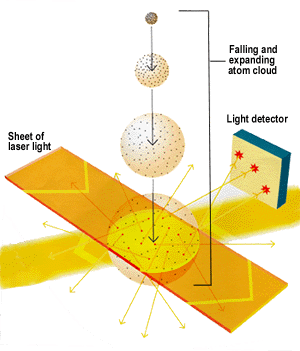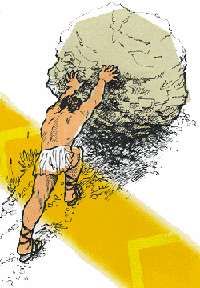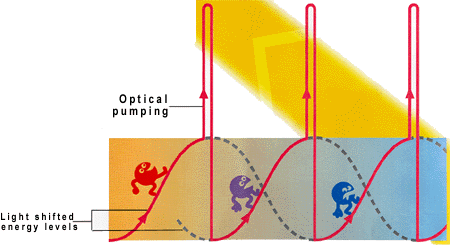The Doppler limit
|
There is a limit for how cold atoms can get with Doppler cooling. In 1988 Phillips developed a time-of-flight method for measuring, and showed that the temperature was considerably below the Doppler limit. Apparently there were other cooling mechanisms at work in the optical molasses. |

Time-of-flight method
The six laser beams are switched off. The atom cloud expands in a way determined by its temperature, at the same time as the atoms fall. They fall through a sheet of laser light and the resulting fluorescence is recorded. Since the atom cloud has expanded the signal has a temporal spread. By measuring this spread the temperature of the cloud can be determined.
New cooling mechanisms
Explanations of the low temperatures were found by Claude Cohen-Tannoudji and by Steven Chu. These were based on the fact that the polarisation of the laser field varies with position in the optical molasses.
One example of the new cooling mechanisms is Sisyphus cooling, where the concepts of light shift and optical pumping play an important role.

Greek mythology has it that Sisyphus must endlessly roll a stone up a hill in the Underworld. As soon as he reaches the top the stone rolls down again.

|
The atoms move on a sinusoidally modulated potential surface, which occurs through changes in their energy levels when they interact with light (light shift). When they travel ‘uphill’ they lose speed. As they reach the top of the ‘hill’ they are optically pumped to the bottom of a ‘valley’. In this way the atoms will always travel ‘uphill’, and thus their velocity will gradually be reduced. This physical picture was developed by Cohen-Tannoudji. The cooling methods described so far are limited by recoils from scattered photons. This means that as long as the atoms scatter light it is impossible to reach temperatures corresponding to lower velocities that is induced by a single recoil. In order to cool below the recoil limit, the laser light must be rendered ‘invisible’ to the atoms while they are being cooled. Cohen-Tannoudji invented a method termed VSCPT (Velocity-Selective Coherent Population Trapping), and Chu another one termed Raman cooling. Recently Cohen-Tannoudji’s group used VSCPT to cool helium atoms to one thousandth of the recoil limit. Over a hundred research groups are now working on laser cooling. Many applications have been tried such as atom optics, atom interferometry, atom lithography, atom clocks, optical lattices, optical tweezers, Bose-Einstein condensation, atom lasers, high-resolution spectroscopy and fundamental investigations of the interaction between light and matter. |
Nobel Prizes and laureates
See them all presented here.
